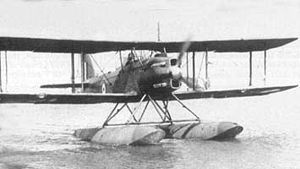Fairey Seafox Video - Picture

|
|
Fairey Seafox
Fairey Seafox

Role: ship-borne reconnaissance seaplane
National origin: United Kingdom
Manufacturer: Fairey Aviation
First flight: 27 May 1936
Introduced: 23 April 1937
Primary user: Fleet Air Arm
Number built: 66
The Fairey Seafox was a 1930s British reconnaissance floatplane designed and built by Fairey for the Fleet Air Arm. It was designed to be catapulted from the deck of a light cruiser and served in the Second World War. Of the total built two were finished as landplanes.
Design and development
Fairey Seafox was built to satisfy Air Ministry Specification S.11/32. The prototype appeared in 1936, first flying on 27 May 1936, and the first production versions were delivered in 1937. The flights were organised as 700 Naval Air Squadron of the Fleet Air Arm.
The fuselage was of all-metal monocoque construction, the wings were covered with metal on the leading edge, otherwise fabric. It was powered by a 16-cylinder 395 hp (295 kW) air-cooled Napier Rapier engine. It reached speeds of 106 mph (171 km/h), had a range of 440 mi (710 km).
A criticism of the Seafox was although the aircraft handled well, it was underpowered, engine cooling was poor, and landing speeds were higher than desired.
Operational history
In 1939, a Seafox played a part in the attack on the German pocket battleship Admiral Graf Spee by spotting for the naval gunners. This led to the ship's destruction after the Battle of the River Plate.
They were utilised up until 1943. The Seafox was operated during the early part of the war from the cruisers HMS Emerald, Neptune, Orion, Ajax, Arethusa, and Penelope and the armed merchant cruisers HMS Pretoria Castle, Asturias, and Alcantara.
Operators
United Kingdom
Fleet Air Arm
700 Naval Air Squadron
702 Naval Air Squadron
703 Naval Air Squadron
713 Naval Air Squadron
714 Naval Air Squadron
716 Naval Air Squadron
718 Naval Air Squadron
754 Naval Air Squadron
764 Naval Air Squadron
765 Naval Air Squadron
773 Naval Air Squadron
Specification
Data from Fairey Aircraft since 1915
General characteristics
Crew: 2
Length: 33 ft 5 in (10.19 m)
Wingspan: 40 ft 0 in (12.20 m)
Height: 12 ft 2 in (3.71 m)
Wing area: 434 ft² (40.3 m²)
Empty weight: 3,805 lb (1,730 kg)
Loaded weight: 5,420 lb (2,464 kg)
Powerplant: 1x— Napier Rapier VI piston, 395 hp (295 kW)
Performance
Maximum speed: 124 mph (108 knots, 200 km/h) at 5,860 ft (1,787 m)
Cruise speed: 106 mph (92 knots, 171 km/h)
Range: 440 mi (383 nmi, 710 km)
Service ceiling: 9,700 ft (2,960 m)
Endurance:4.25 hours
Climb to 5,000 ft (1,520 m): 15.5 min
Armament
1 x 7.7mm machine gun
Comparable aircraft
SOC Seagull
Mitsubishi F1M
Bibliography
"For Light Reconnaissance" (PDF). Flight, 9 December 1937. pp.570-574.
Mondey, David. The Hamlyn Concise Guide to British Aircraft of World War II. London; New York: Aerospace Publishing Ltd., 1982. P.87. ISBN 0600349519, ISBN 0600349675.
Taylor, H.A. Fairey Aircraft since 1915. London: Putnam, 1974. ISBN 0-370-00065-x.
Fairey Seafox Pictures
More aircraft.
Source: WikiPedia